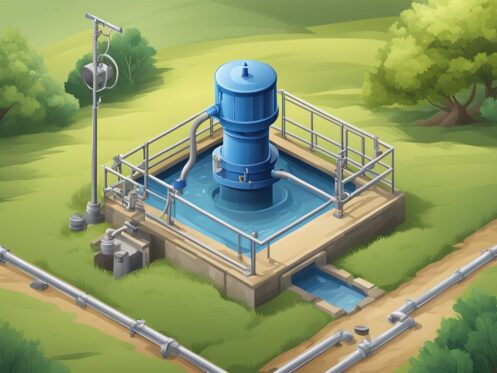When it comes to ensuring reliable water supply in your home, understanding water well plumbing is essential. Properly functioning well plumbing not only safeguards your water quality but also increases the efficiency of your system. Familiarizing yourself with the basics can save you time, money, and headaches down the road.
Many homeowners overlook the importance of regular maintenance for their water well systems. Neglect can lead to issues such as reduced water pressure, contamination, and costly repairs. At Splash Plumbing, we emphasize the significance of routine checks and expert interventions to keep your well in top shape, ensuring you always have access to clean and safe water.
With decades of experience, our team stands ready to assist you with any plumbing needs related to your water well. Whether it’s installation, repair, or maintenance, Splash Plumbing is your trusted partner in maintaining a well-functioning water supply for your home.
Understanding Water Well Systems
A thorough understanding of water well systems is essential for homeowners relying on well water for their supply. This knowledge will help you appreciate the key components involved and how groundwater serves your needs.
Components of a Water Well
A water well system consists of several critical components that function together to provide you with clean, safe water. At the core is the well itself, which taps into underground water sources known as aquifers.
- Well Screen: This prevents debris from entering the system, protecting the pump.
- Pump: It draws water from the well and pushes it into your plumbing.
- Pressure Tank: Maintains water pressure and stores water until needed.
- Filtration System: Ensures water quality by removing contaminants.
This interconnected system plays a vital role in your daily water supply. Proper maintenance of these components is crucial to avoid issues like low water pressure or contamination.
The Role of Groundwater in Water Supply
Groundwater is the primary source for well water, stored beneath the earth’s surface in aquifers. Understanding the groundwater dynamics is key to ensuring a stable water supply.
The water table indicates the height of groundwater in an area. You may encounter either a high water table, which is generally easier to access, or a low water table, requiring deeper drilling to reach water.
Groundwater replenishes naturally through precipitation and surface water infiltration, maintaining a balance crucial for your well’s sustainability. This relationship emphasizes the importance of responsible water management to prevent depletion and contamination.
If you need assistance with your well system in Anaheim, CA, consider working with Splash Plumbing for professional support.
Well Pump Types and Functions
Understanding the different types of well pumps and their functions is crucial for effective water delivery and management. This section discusses jet pumps and explores the advantages of submersible pumps, outlining essential details relevant to your needs.
Jet Pumps and Their Operation
Jet pumps are typically installed above ground and are designed for shallow to moderately deep wells. They operate using a combination of mechanical suction and water pressure. A pump motor drives the water through the jet assembly, which creates a vacuum effect that pulls water into the system.
In this setup, the impeller forces water into the jet, where high-speed water creates a low-pressure area that draws in more water from the well. Jet pumps are easier to maintain compared to other types, making them a popular choice for many homeowners. They can function efficiently for wells up to about 110 feet deep, suitable for various household applications. For installations tailored to your specific needs, consider reaching out to Splash Plumbing.
Submersible Pump Advantages
Submersible pumps are designed to be fully submerged underwater, making them ideal for deeper wells. These pumps use an electric motor located at the bottom of the pump to push water to the surface, providing a consistent flow of water without having to rely on suction.
One significant advantage of submersible pumps is their durability; they are built to withstand harsh conditions and have a longer lifespan compared to other pump types. They require less maintenance, as they work submerged and are less exposed to external elements. In terms of efficiency, submersible pumps can offer better performance for deeper wells, making them a reliable choice for those with access challenges. For expert recommendations and services, look to Splash Plumbing for your well pump needs.
Water Pressure Management
Maintaining ideal water pressure in your well system is crucial for efficient operation. Proper management involves monitoring pressure tanks, using pressure gauges, and ensuring the pressure switch is set correctly to deliver consistent water pressure throughout your home.
Pressure Tanks and Pressure Gauges
Pressure tanks serve a key function in regulating water pressure. They store water and maintain a set pressure in your plumbing system, which helps supply water without overwhelming your pipes. The ideal pressure range for most residential well systems is typically between 40 and 60 psi.
You can monitor this pressure using a pressure gauge, which should be easily accessible. Ensure the gauge is calibrated properly to avoid malfunctions. A watchful eye on both the tank and gauge helps prevent issues such as water hammer, which can occur when pressure fluctuates suddenly. If you experience abnormal pressure readings, it might indicate a problem with your check valve or pressure tank itself.
Importance of the Pressure Switch
The pressure switch is essential for maintaining consistent water pressure. It automatically turns the well pump on and off based on the pressure levels. Generally, a setting of 30/50 or 40/60 psi is preferred for optimal performance.
A malfunctioning pressure switch can lead to insufficient water supply or excessive cycling of the pump. Regular maintenance of this component is advised to ensure its reliability. Adjust the cut-in and cut-out pressures carefully to align with your household’s needs. For assistance with pressure management, consider reaching out to professionals like Splash Plumbing, who can provide expert guidance tailored to your system.
Plumbing System Integration
Integrating plumbing systems with water well components is vital for maintaining an effective water supply. A balanced approach ensures that both your well and household plumbing function optimally for your daily needs.
Connecting the Well System to Household Plumbing
To connect your water well system to household plumbing, proper understanding of piping and components is essential. The well should be equipped with a pump that draws water up, which then travels through a series of pipes to reach your home.
Focus on using high-quality materials for splicing pipes to prevent leaks and ensure longevity. Installing a curb stop or shut-off valve is recommended for controlling water flow. Proper pressure tanks also help maintain consistent flow rates, which is crucial for reliable water access.
Ensuring Reliable Water Supply
Ensuring a reliable water supply involves regular maintenance and monitoring of your well system. Routine checks can help identify potential issues like low water levels or pump malfunctions.
You should keep an eye on water pressure; fluctuations can indicate a problem in the system. Consider installing water filtration systems to guarantee that your drinking water is clean and safe.
For any concerns or assistance, consult professionals from Splash Plumbing, who are well-versed in maintaining well systems and ensuring efficient plumbing operations.
Water Quality and Filtration
Maintaining high water quality in your well is essential for health and safety. Proper filtration systems play a critical role in ensuring that the water you consume is free from harmful contaminants.
Protecting and Improving Your Water Quality
To protect your water quality, regular testing is vital. You should monitor for contaminants like bacteria, nitrates, and heavy metals. Consider installing a well screen to prevent sediments and debris from entering your water supply. This component filters out larger particles, improving the overall quality of your water.
Using a pressure relief valve can also help manage pressure fluctuations, preventing potential damage to your plumbing system. Regular maintenance is necessary to keep your well casing intact, as it helps safeguard against surface contaminants. If issues arise, it may be time to consult professionals like Splash Plumbing for advice on improving your water quality.
Types of Water Filters and Their Installation
There are various water filters available to address specific contaminants in your well water. Some popular options include:
- Activated Carbon Filters: Effective for removing chlorine, taste, and odor.
- Reverse Osmosis (RO) Systems: Great for reducing dissolved solids, including heavy metals.
- Sediment Filters: Useful for capturing dirt and particles before they enter your plumbing.
Installation can vary by type; for example, RO systems often require more space and may need additional plumbing modifications. It’s essential to follow the manufacturer’s instructions for installation to ensure optimal performance.
Splash Plumbing can assist with proper setup and maintenance, ensuring your filtration system works efficiently for better drinking water.
Frequently Asked Questions
Understanding water well plumbing involves a range of technical details. The following questions address installation processes, system components, pipe recommendations, plumbing replacement steps, troubleshooting pump issues, and potential disadvantages of using well water.
How do you install plumbing for a residential water well system?
To install plumbing for a residential well system, start by identifying the location of the well and the house. Then, install the pump to draw water from the well, ensuring it is connected to the pressure tank. The plumbing layout should lead from the pressure tank to your home’s water distribution system, with proper sealing to prevent leaks.
What are the common parts of a residential well water system?
Key components of a residential well water system include the well casing, pump, pressure tank, control box, and piping. Each component plays a vital role in ensuring water is drawn from the well and distributed throughout your home. Regular checks and maintenance of these parts are crucial for optimal performance.
Which pipes are recommended for well water systems to ensure quality and durability?
For well water systems, PVC and polyethylene pipes are commonly recommended due to their durability and resistance to corrosion. These materials help maintain water quality and reduce the chances of contamination. Choosing the right pipe size is essential for proper flow rates and system efficiency.
What steps are involved in replacing plumbing in a water well system?
When replacing plumbing in a water well system, first shut off the power supply to the pump. Drain the system to prevent spills, then remove the old plumbing carefully. Install the new pipes, ensuring all connections are secure. Finally, refill the system and restore power while checking for leaks.
How do you troubleshoot a residential well water pump that is not working effectively?
To troubleshoot an ineffective well water pump, start by checking the power supply and ensuring the circuit breaker is not tripped. Inspect the pressure tank and connections for leaks or malfunctions. If water is not flowing, the pump may need repair or replacement.
What are some potential disadvantages of using well water in a residential setting?
Using well water can come with disadvantages, such as the necessity for regular testing to ensure water quality. Contaminants may affect health and require treatment systems. Additionally, well water supply can be inconsistent during droughts or dry seasons, impacting your home’s water availability. Splash Plumbing can assist with maintaining your well water system and addressing any concerns you may have.












